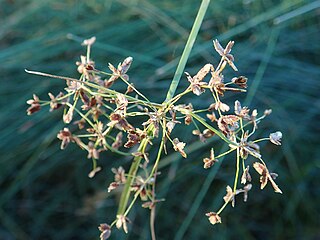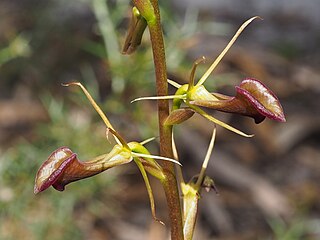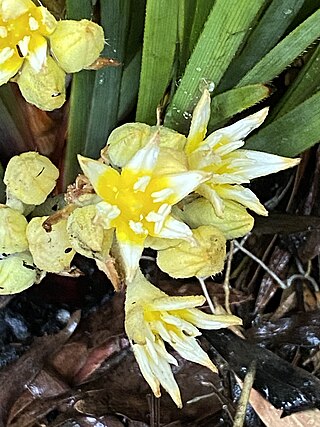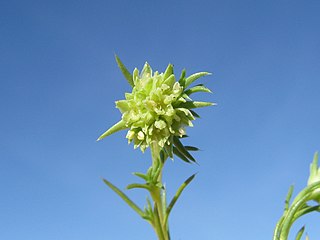
Bulbine bulbosa, commonly known as bulbine lily, native leek, golden lily, or native onion, is a species of flowering plant in the family Asphodelaceae and is endemic to Australia. It is a perennial herb with thick roots, channelled leaves, and yellow flowers with hairy stamen filaments.

Dampiera linearis, commonly known as common dampiera or wedge-leaved dampiera, is an erect perennial herb in the family Goodeniaceae. The species, which is endemic to the south-west of Western Australia, grows to between 15 and 60 cm high, with its blue to purple flowers appearing between July and December. It adapts readily to cultivation, particularly containers such as hanging baskets.

Dianella revoluta, commonly known as blueberry lily, blue flax-lily, or black-anther flax-lily, a species of flowering plant in the family Asphodelaceae and is endemic to, and widespread in Australia. It is a tufted, perennial herb with grass-like leaves and up to nine blue or violet flowers with six tepals, and stamens with bright yellow filaments and pale brown to almost black anthers.

Conostylis aculeata, commonly known as prickly conostylis, is a flowering, tufted perennial plant in the family Haemodoraceae. It has flat leaves and yellow, hairy, tubular flowers. It is endemic to the south-west of Western Australia.

Johnsonia is a genus composed of five species of herbs in the family Asphodelaceae, all of which are endemic to the south-west of Western Australia. They are grass-like plants with minute flowers surrounded by bracts which are often tinged with white, pink or cream.

Cyperus concinnus is a sedge of the family Cyperaceae that is native to Australia, and found in New South Wales, Queensland, the Northern Territory, South Australia, Victoria and Western Australia.
Prasophyllum gibbosum, commonly known as the humped leek orchid, is a species of orchid endemic to the south-west of Western Australia. It is a late-flowering leek orchid with a single smooth, tubular leaf and up to eighty or more purplish-red and white flowers with a smooth labellum. It is similar to P. cucullatum but that species has a frilly labellum, usually a shorter flowering stem and an earlier flowering period.

Diuris setacea, commonly called the bristly donkey orchid, is a species of orchid that is endemic to the south-west of Western Australia. It has a tuft of up to ten twisted leaves at its base and up to seven yellow flowers with a few brown markings. It grows in moist soil on granite outcrops and flowers much more prolifically after fire the previous summer.
Thelymitra tigrina, commonly called the tiger orchid or tiger sun orchid, is a species of orchid that is endemic to the south-west of Western Australia. It has a single narrow leaf and up to fifteen small yellow flowers with small brown spots.

Cryptostylis ovata, commonly known as slipper orchid or western tongue orchid, is an orchid endemic to Western Australia. It is a common, summer flowering species with dark green leaves with a white central vein and up to fifteen pale greenish flowers with a brownish red labellum with a network of darker veins.

Xyris gracilis, commonly known as slender yellow-eye, is a species of flowering plant in the family Xyridaceae and is endemic to eastern Australia. It is a tufted herb with linear leaves with 5 to 8 flowering stems with bright yellow flowers.

Goodenia humilis, commonly known as swamp goodenia, is a species of flowering plant in the family Goodeniaceae and is endemic to south-eastern Australia. It is a weak, perennial herb with linear to lance-shaped leaves mostly at the base of the plant, and racemes or thyrses of yellow or yellowish-brown flowers.
Goodenia purpurascens is a species of flowering plant in the family Goodeniaceae and is native to northern Australia and New Guinea. It is usually a perennial herb with linear to lance-shaped leaves at the base of the plant, and thyrses or panicles of purple flowers.

Scaevola striata, commonly known as royal robe, is a species of flowering plant in the family Goodeniaceae. It has blue fan-shaped flowers, and is endemic to Western Australia.

Goodenia viscida, commonly referred to as viscid goodenia, is a species of flowering plant in the family Goodeniaceae and is endemic to the south-west of Western Australia. It is an erect perennial herb or shrub with narrow oblong to egg-shaped leaves with toothed edges, and spikes of yellow flowers.

Dampiera incana, commonly known as the hoary dampiera, is a flowering plant in the family Goodeniaceae and is endemic to Western Australia. It is a perennial herb with grey foliage and blue-purple flowers.

Conostylis serrulata is a flowering plant in the family Haemodoraceae and is endemic to the south-west of Western Australia. It is a small perennial with yellow cream flowers and flat, green leaves.

Patersonia lanata, commonly known as woolly patersonia, is a species of flowering plant in the family Iridaceae and is endemic to the south of Western Australia. It is a tufted perennial herb with sword-shaped leaves and blue-violet flowers.

Lechenaultia tubiflora, commonly known as heath leschenaultia, is a species of flowering plant in the family Goodeniaceae and is endemic to the south-west of Western Australia. It is a hemispherical subshrub or more or less erect perennial with crowded, narrow, rigid leaves and variably-coloured, tube-shaped flowers.

Scleranthus diander commonly known as tufted knawel, is a flowering plant in the family Caryophyllaceae, it grows in eastern states of Australia and the Australian Capital Territory. It is a small, spreading herb with white or light green flowers.



















